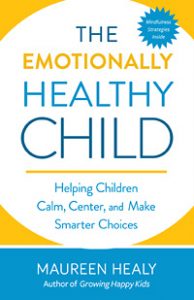
These Four Big-Picture Skills Will Help Your Children Become Emotionally Healthier
An excerpt from The Emotionally Healthy Child by Maureen Healy
With the National Institute of Mental Health reporting that 25 percent of children experience anxiety and 14 percent have a mood disorder, and National Public Radio sharing that as many as five million public school students have mental-emotional issues such as depression and anxiety, award-winning Maureen Healy’s new book The Emotionally Healthy Child: Helping Your Child Calm, Center, and Make Smarter Choices (New World Library, October 9 2018) couldn’t be more perfectly timed.
In The Emotionally Healthy Child, Healy explains that emotional health is the ability to make better choices, even when feeling anger or another big emotion. She describes that the ability to — Stop, Calm, and Make a Smarter Choice — are key to expressing emotions constructively. While not always easy, these steps are powerful, and Healy shows readers exactly how to implement them so they can help children find equilibrium in the moment and build emotional well-being over the long-term. I hope you’ll enjoy this excerpt from the book.
One of my most memorable family trips as a child was going to the Metropolitan Museum of Art in New York City. I fell in love with the Egyptian wing, seeing mummies and hearing the stories of the hieroglyphs and scribes, as well as seeing the artwork, especially the Impressionist paintings. Clear as day, I still remember standing in front of a Seurat painting (A Sunday Afternoon on the Island of La Grande Jatte) and being mystified. Up close, I couldn’t make out the image. But as I slowly moved back, the forms came into view. Twenty feet away, I could see the painting beautifully.
Children’s emotions are like this Seurat painting: when we view them up close, it’s sometimes challenging to see what’s happening, but with distance and time, things become clear. With emotional health, we need to take a step back to see the big picture before we can understand the key skills needed in a given situation. For example, Billy was in second grade, and his parents were getting messages from the principal daily about how their son was misbehaving. Knowing that children don’t misbehave for no reason, I met with Billy and discovered that he himself was being bullied. He was taunted on the playground when no one was looking, but somehow the teacher only seemed to show up when Billy pushed or hit someone in retaliation.
School officials deemed Billy a “bad apple,” based on his teacher’s reports, but that wasn’t the truth of the situation. Stepping back, we can see that Billy was being teased relentlessly, which the school didn’t appreciate. They saw Billy as a behavior problem, which in the context of being teased daily is somewhat understandable, albeit still not acceptable. I could see Billy’s pain and his need to learn how to navigate his challenging emotions and to get into a better environment.
Understanding the big picture of emotional health helped me advocate for Billy, build his skills of emotional health, and ultimately guide his family to move him to a new school, which made a huge and positive difference (no more calls from the principal).
The Essential Skills
Emotionally healthy children aren’t simply born — they are made. They’re nurtured and taught skills that help them identify their emotions and constructively express them so they can connect with others in emotionally intelligent ways. But before children begin learning about their emotions in earnest, they typically are very emotionally reactive, which creates a ripple effect of problems for parents, teachers, and anyone in their vicinity, even the quiet-seeking neighbors.
But once children learn how to slow down, calm, and then make smarter choices with their big feelings, a change occurs. They learn how to display self-control and gain awareness of their varied emotions. On this journey, four big-picture skills will help your children become emotionally healthier, and they are the ability to:
1. pay attention
2. respond (versus react)
3. press pause
4. make a smart choice
Although these steps may sound simple, they’re not necessarily easy. They take practice and patience from adults as well as children, but they’re possible for every healthy child.
Maureen Healy is the author of The Emotionally Healthy Child and Growing Happy Kids, which won the Nautilus and Readers’ Favorite book awards in 2014. A popular Psychology Today blogger and sought-after public speaker, Maureen runs a global mentoring program for elementary-aged children and works with parents and their children in her busy private practice. Visit her online at www.growinghappykids.com.
Excerpted from the book The Emotionally Healthy Child. Copyright ©2018 by Maureen Healy. Printed with permission from New World Library — www.newworldlibrary.com.
